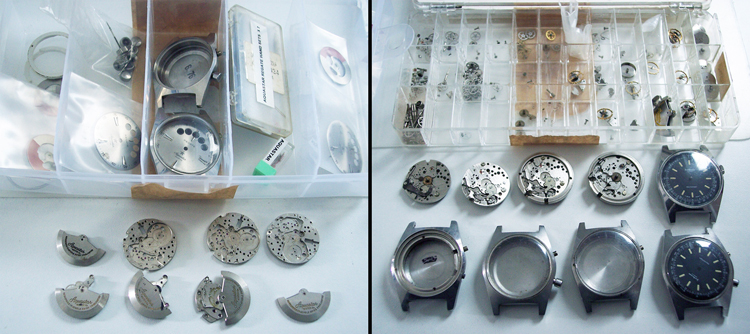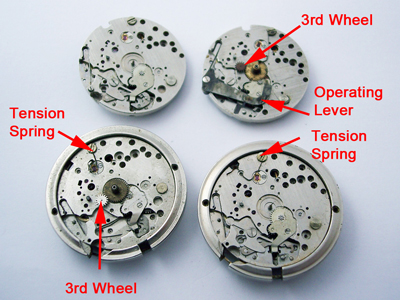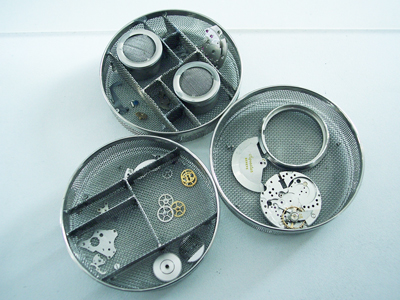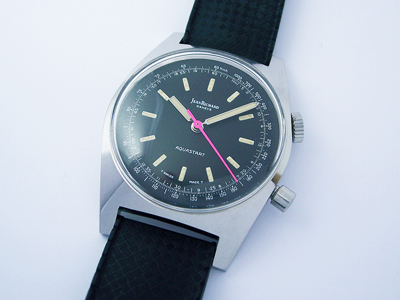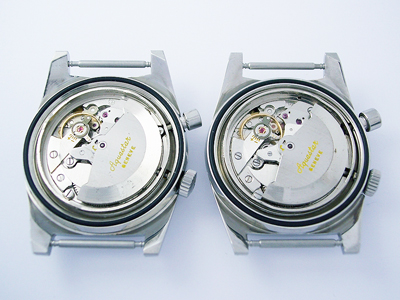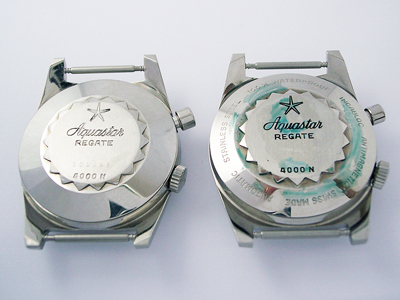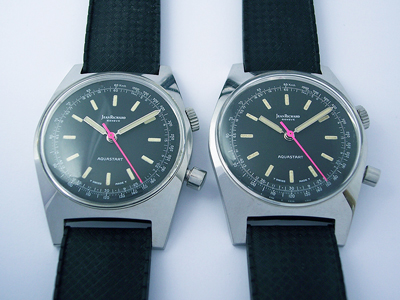Having covered most of Aquastar’s vintage models, it may be surprising that I haven’t written about any JeanRichard watches on the blog. So, let’s put that right!
(Click pictures to enlarge)
Aquastar enthusiasts will undoubtedly be familiar with the JeanRichard name as ‘Aquastar Instruments S.A.’ was registered as a sub-brand of JeanRichard in 1962, by the then owner Frédéric Robert.
Some of the existing JeanRichard models were moved across to the Aquastar brand, but the “Aquastart” is something of an enigma as there is very little information available about it, well, anywhere really.
Exactly how many were made and the reason for its production is unknown. It was never sold as an official JeanRichard model, never appeared in any promotional material or catalogues, and there are currently only around ten known examples world-wide – a rare bird then!
I was asked by the owner, who had bought a collection of Aquastar/JeanRichard spare parts, if I’d be interested in trying to piece back together as many working watches as possible, with the Aquastart being a priority.
Ordinarily, I would have politely declined as I’m no longer working on the Aquastar sailing timers, due to a lack of available parts, but having studied the pictures and with so many loose parts and partial movements available, I was hopeful that there would be one of everything so that I could at least resurrect the Aquastart.
However, when the collection arrived, I quickly realised that although there were seven watches in various states of disrepair, they had already been picked over, which was a concern.
As anyone knows who has tried to restore a Felsa powered Aquastar Regate, the timer specific parts can be a ‘project killer’, as they are unique to the 4000N calibre and in very short supply.
As you can see in the first picture, the watch arrived in a partially disassembled condition, the hands had been removed and the pusher for the timer was missing.
Turning the watch over, you can see immediately that the watch has a regular ‘star’ caseback, rather than the monobloc case seen on the earliest Regate models (a monobloc example here). The caseback on the watch also proved to be an interesting part of the Aquastart puzzle as it had no serial number.
It is thought that all Aquastarts may have been produced without serial numbered cases, but with so few in circulation, it’s hard to know for sure. The caseback on this watch still had most of its original sealing wax too, suggesting that it had never been used.
Removing the caseback revealed the expected Felsa cal. 4000N calibre, and I was pleased to see a simple yellow ‘Aquastar Geneve’ branded rotor with the ribbed decoration found on the early Regate movements.
Although not running, the movement looked to be relatively complete and in reasonable condition. I did find on removing the dial that, unfortunately, this movement too had been picked over. It was missing its timer disc, operating lever, driving wheel (the third wheel shaft had been broken off) and tension spring, so there was some scavenging to be done.
Thankfully, looking over the other movements, there were enough timer parts available to be able to rebuild a working movement… just!
There was only one operating lever, which immediately scuppered any chances of building more watches, and all the tension springs present were in very poor shape and would need careful handling to try and save them.
As I’ve mentioned in a previous Regate post, the shape of the tension spring is crucial to the successful functioning of the timer mechanism as it needs to provide just the right amount of friction, or the timer gets stuck. (A full description of how the timer mechanism works is available in a previous Regate post here.)
With the movement disassembled and any sub-par parts swapped out, after a trip through the cleaning machine, things were looking promising for a successful rebuild.
What isn’t obvious is the purpose of this watch. The first thing to note is that it has exactly the same movement and functions as a standard Aquastar Regate sailing timer, ie. when the pusher is pressed, the sweep second hand rotates back to the top of the dial. The timer disc under the dial is moved to the ‘starting’ position, and for the next five minutes it slowly rotates back to its original ‘stopped’ position.
The main difference between the Regate and the Aquastart is that the latter has no apertures in the dial to facilitate the countdown timer. So, with no independent bezel or minute counter, unless you’re watching closely, you have no idea how many minutes have passed.
The dial does have a tachymeter scale, so it could be used as a traditional chronograph, but with no method of stopping the sweep hand, it would be difficult to get an accurate reading.
As you can see here, despite the lack of ‘dial windows’, the Aquastart still has a complete timer mechanism under the dial.
With the movement rebuilt and fully functional, it was on to the cosmetic work. The main case was cleaned, a pusher salvaged from one of the other cases, the original crystal polished, a new caseback gasket fitted and the caseback carefully cleaned by hand (though even then, much of the original sealing wax just flaked off with the slightest touch, which was a shame.)
The last thing to do was to restore a set of hands. There were several sets to choose from, so I opted to clean and relume five sets in total in slightly different shades, so that I could pick out the ones that best matched the original lume on the dial when dry.
With that job done, the finish line was homing into view and I was finally able to rebuild the watch.
But the story doesn’t end there…. the eagle-eyed amongst you may have spotted in the parts picture above that there was another Aquastart dial lurking inside one of the cases.
After a successful result with the first watch, looking through all the parts again, and with some sterling work from the owner to source some missing timer parts (thanks Ian!), I was able to repeat the whole process again, giving me the rare opportunity to photograph two Aquastarts together – not something that I’ll be able to repeat in a hurry, that’s for sure!
It’s worth noting that the caseback on the second watch has a serial number, but no lettering around the outside of the caseback, something I’ve never seen before on any Aquastar or JeanRichard watch. As with the first watch, whether this is ‘correct’ for an Aquastart caseback remains open for debate.
Are there many more out there? If you own a JeanRichard Aquastart and/or can provide any more information on the history of the model, I’d be very interested to hear from you.
Rich.
Many thanks to Ian Wilkinson for letting me feature his watches on the blog, and to Henrik from HeuerChrono for his help whilst researching the model.


